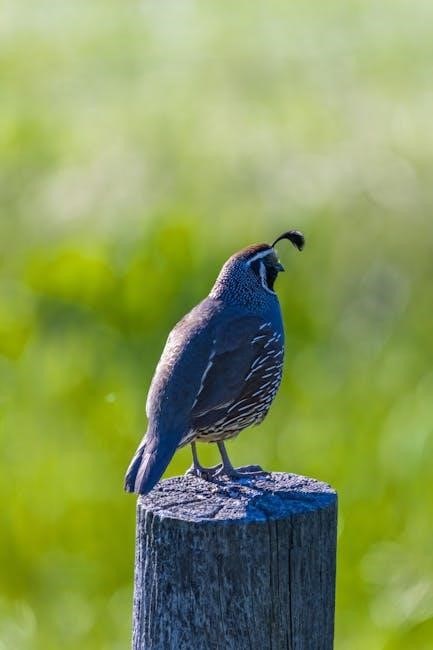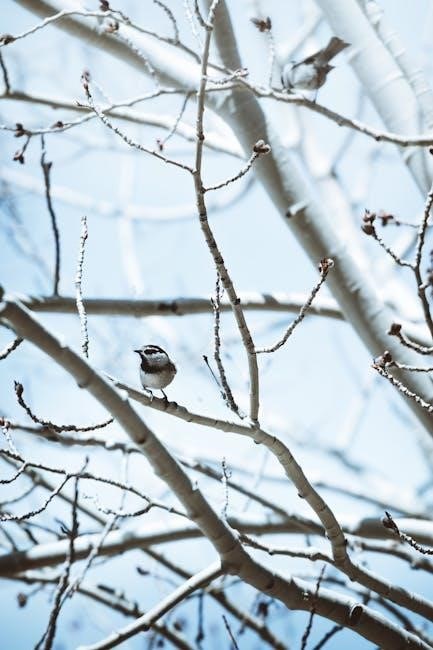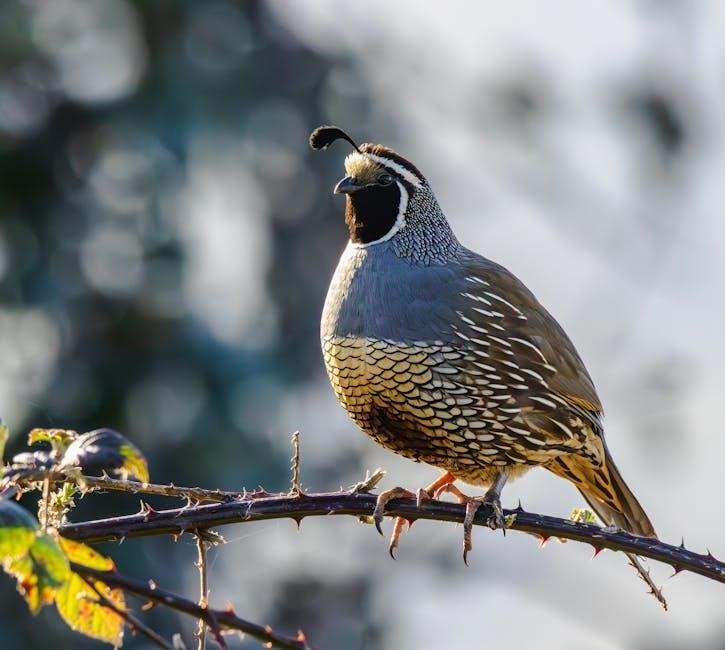California boasts an incredible diversity of birdlife, with over 600 species documented. From coastal wetlands to mountainous regions, the state offers a birdwatcher’s paradise, attracting enthusiasts worldwide.
1.1 Overview of California’s Biodiversity
California’s unique geography and climate create a haven for diverse wildlife, particularly birds. The state’s vast landscapes, from coastal wetlands to arid deserts and mountain peaks, support over 600 species. This biodiversity hotspot attracts migratory birds, resident species, and rare endemics. The interplay of Pacific influences, varied terrain, and abundant habitats fosters an environment where species thrive. California’s role as a critical stopover for migratory routes enhances its ecological significance. Birdwatchers and conservationists alike are drawn to this avian richness, making it a cornerstone of the state’s natural heritage. The diversity of birdlife underscores California’s importance in global ecosystems.
1.2 Importance of Birdwatching in Conservation
Birdwatching plays a vital role in conservation efforts by promoting awareness and engagement with avian species. Citizen science projects rely on birders to collect data on populations, habitats, and migration patterns, aiding researchers in understanding ecosystem health. This hobby fosters a deeper connection to nature, encouraging advocacy for environmental protection. By supporting eco-tourism, birdwatching also generates revenue for local communities, which can fund conservation initiatives. Additionally, it educates the public about the importance of preserving habitats and addressing threats like climate change. Birdwatching bridges the gap between recreation and activism, making it an indispensable tool for safeguarding California’s rich birdlife and broader biodiversity.

Key Bird Habitats in California
California’s diverse landscapes, including coastal wetlands, mountain forests, deserts, and Central Valley grasslands, provide critical habitats for its rich avifauna, attracting species from across North America.
2.1 Coastal Ecosystems
California’s coastal ecosystems, such as estuaries, mangroves, and tidelands, are vital for migratory birds. These areas provide essential feeding and breeding grounds, supporting species like the Snowy Plover and Western Sandpiper. The mix of saltwater and freshwater creates a unique environment rich in invertebrates, which birds rely on for sustenance. Additionally, coastal wetlands serve as critical stopover points during migration, allowing birds to rest and replenish energy reserves. The diversity of habitats along the coast attracts both resident and migratory birds, making these regions a hotspot for birdwatching. Conservation efforts are crucial to protect these sensitive ecosystems from threats like urbanization and climate change, ensuring the continued health of California’s avifauna.
2.2 Mountainous Regions
California’s mountainous regions, such as the Sierra Nevada, provide a unique habitat for a variety of bird species. These areas are characterized by coniferous forests, alpine meadows, and rocky outcrops, which support birds like the Steller’s Jay and Mountain Bluebird. The elevation gradients create a diversity of microhabitats, allowing species to thrive in different ecological niches. Migratory birds also use these regions as stopover points, while others, such as the White-headed Woodpecker, are year-round residents. The mountains’ isolation has led to the evolution of endemic species, making them a fascinating area for birdwatchers. Conservation efforts are essential to protect these high-altitude ecosystems from habitat loss and climate change, ensuring the survival of California’s mountain bird populations.
Bird Identification Tips
Bird identification involves observing plumage, beak shape, size, and behavior. Listening to bird calls and noting flight patterns are also key. Use field guides to confirm species accurately.
3.1 Using Plumage and Coloration
Plumage and coloration are essential for identifying California’s birds. Distinctive feather patterns, vibrant hues, and seasonal changes in appearance help distinguish species. For example, the Western Tanager’s bright orange head contrasts with its yellow body, while the Anna’s Hummingbird displays iridescent green feathers. Observing these traits, along with wing bars, cap colors, and tail markings, provides crucial clues. Field guides often highlight these features, enabling precise identification. Additionally, noting how colors vary between males and females, or across seasons, can aid in accurately determining species. Paying attention to these visual cues enhances birdwatching experiences and ensures accurate identifications in the diverse California avifauna.
3.2 Understanding Bird Calls
Bird calls are a vital tool for identifying species, especially when visual sightings are challenging. California’s diverse avifauna produces a wide range of sounds, from melodic songs to distinctive chirps. For instance, the Northern Flicker’s loud, piercing “wicka” call is unmistakable, while the Great Horned Owl’s deep hooting resonates at night. Learning these vocalizations helps birders locate and identify species accurately. Many birds have unique call patterns, such as the repetitive “cheer-up” of the Yellow Warbler or the raspy “kek-kek-kek” of the Black-crowned Night-Heron. Field guides often include audio recordings or written descriptions of calls, aiding enthusiasts in refining their listening skills. Recognizing these sounds enhances the birdwatching experience and improves species identification in California’s rich birding landscapes.

Popular Bird Species in California
California is home to a variety of iconic bird species, including the Western Scrub Jay, California Quail, and Anna’s Hummingbird, each thriving in diverse habitats across the state.
4.1 Endemic Species
California is home to several bird species that are endemic, meaning they are found nowhere else in the world. The California Quail, with its distinctive topknot, is the state bird and a symbol of its rich avifauna. Another notable endemic species is the Island Scrub Jay, which inhabits the Channel Islands. The Nuttall’s Woodpecker, a small but vibrant woodpecker, is also unique to the region. These birds have adapted to California’s diverse habitats, from chaparral to coastal woodlands. Their unique characteristics and limited ranges make them a focal point for birders and conservationists. Protecting these endemic species is crucial for maintaining the state’s ecological balance and biodiversity, as they play vital roles in their specific ecosystems. Efforts to preserve their habitats are essential for ensuring their survival.
4.2 Migratory Visitors
California serves as a critical stopover and wintering ground for numerous migratory bird species. Each year, millions of birds traverse the state, utilizing its diverse habitats to rest and refuel. Species like the Western Sandpiper and the Semipalmated Plover migrate from Arctic breeding grounds to South America, relying on California’s coastal wetlands. Waterfowl such as the Northern Pintail and Green-winged Teal overwinter in the Central Valley and coastal marshes. Songbirds like the Wilson’s Warbler and Yellow-rumped Warbler pass through during spring and fall migrations. These migratory visitors highlight California’s importance in global bird migration patterns. Their presence enriches the state’s birdlife, offering birders a chance to observe species not seen during the breeding season. Conservation of these habitats is vital to ensure the survival of these migratory birds.

Seasonal Birding in California
California offers exceptional birding opportunities year-round, with peak seasons in spring and fall migrations. The state’s diverse habitats attract a wide variety of species, making it a top destination for bird enthusiasts.
5.1 Spring Migration Hotspots
California’s spring migration is a spectacle, with millions of birds passing through the state. Key hotspots include the Central Valley, coastal wetlands, and mountain regions. The Sacramento Valley and San Joaquin Valley are vital stopovers for waterfowl and shorebirds, while the Pacific Flyway brings songbirds and raptors. Coastal areas like Point Reyes and Monterey Bay are renowned for their diversity, offering sightings of species like the Western Tanager and Pacific-slope Flycatcher. The Sierra Nevada foothills also attract migratory birds seeking higher elevations. Peak migration occurs from March to May, with abundant food and shelter drawing species from as far as South America. These regions make California a premier destination for spring birding, showcasing the state’s critical role in global migration patterns.
5.2 Wintering Grounds

California’s wintering grounds are critical for numerous bird species seeking refuge from colder climates. The Central Valley, with its vast wetlands and agricultural fields, is a key destination for waterfowl like ducks and geese. Coastal regions, such as the San Francisco Bay and Humboldt Bay, provide essential habitat for shorebirds and seabirds. Southern California’s deserts and inland valleys also attract species like sparrows and finches. The Salton Sea, despite its challenges, remains a vital wintering site for migratory birds. These areas offer abundant food and shelter, supporting species like the Northern Shoveler, American Wigeon, and Sandpipers. Birdwatchers flock to these locations during winter months to observe the diverse avifauna, making California a crucial stopover in North America’s migratory network.
Conservation Efforts and Threats
California’s bird populations face threats from habitat loss, climate change, and urbanization; Conservation efforts focus on restoring wetlands and protecting nesting sites to ensure avian diversity thrives.
6.1 Protecting Bird Populations
Protecting bird populations in California involves a mix of habitat restoration and policy enforcement. Wetland preservation projects, such as those in the Sacramento Valley, aim to create safe breeding and migratory stops. National wildlife refuges play a crucial role, offering protected areas for endangered species like the western snowy plover. Additionally, organizations collaborate with local communities to promote eco-friendly practices, reducing pesticide use and maintaining avian-friendly ecosystems. Legal measures, including the California Endangered Species Act, safeguard threatened birds, while public awareness campaigns highlight the importance of conservation. These efforts collectively work to stabilize and grow bird populations, ensuring their survival for future generations.
6;2 Climate Change Impact
Climate change poses significant threats to California’s bird populations. Rising temperatures and shifting precipitation patterns disrupt breeding and migration cycles, affecting species like the western snowy plover. Warmer winters alter habitat conditions, displacing birds that rely on specific ecosystems. Sea-level rise threatens coastal nesting sites, while droughts impact inland water sources, reducing food availability. These changes force birds to adapt, but many species struggle to cope, leading to declining populations. Conservation efforts must address these challenges to safeguard California’s avifauna, emphasizing habitat protection and climate-resilient strategies to ensure their survival in a rapidly changing environment.